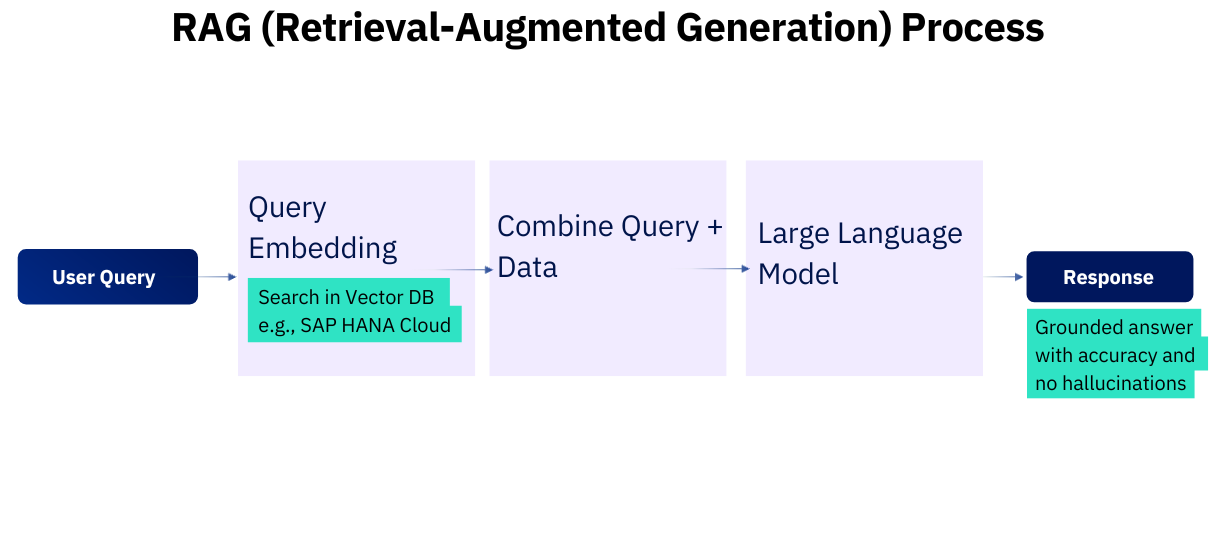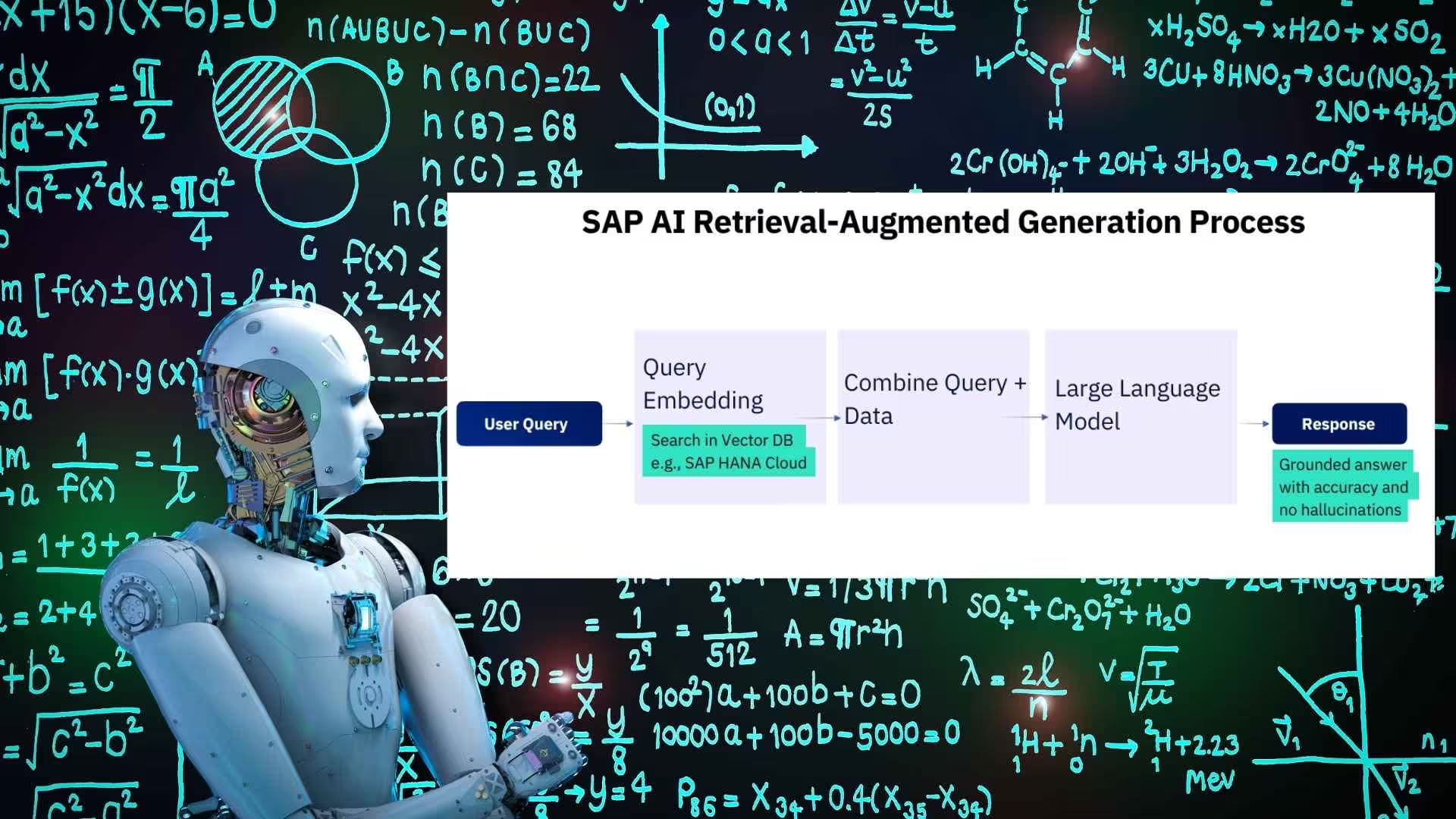Revolutionizing Business AI: The Power of Retrieval-Augmented Generation(RAG) in SAP
The rapid advancements in artificial intelligence (AI), particularly with large language models (LLMs), have opened doors to more intelligent business solutions.
However, challenges like hallucination—where models provide incorrect or misleading information—present significant hurdles.
A key innovation addressing this issue is Retrieval-Augmented Generation (RAG). RAG combines the strengths of LLMs with real-time data retrieval, offering businesses a practical and cost-effective solution for contextual, grounded insights.
In this post, we’ll explore what RAG is, why it’s needed, and how SAP is enabling its customers to harness its power with real-life examples.
What is Retrieval-Augmented Generation (RAG)?
RAG is a framework that enhances traditional generative AI by integrating a retrieval mechanism.
When an AI model receives a query, it retrieves relevant information from a database or document repository, allowing the model to generate responses grounded in real-time, up-to-date information.
This process drastically reduces the risk of hallucinations, making the AI outputs more relevant and trustworthy for business applications.

In simple terms, RAG brings together two main components:
- Retrieval: Accessing relevant documents or data in response to a query.
- Generation: Using that retrieved information to generate a coherent and contextually appropriate answer.
Why is RAG Needed?
While LLMs have revolutionized AI-driven insights, they still face several limitations in real-world applications, particularly for businesses:
- Hallucinations: LLMs may provide factually incorrect or irrelevant answers, especially when they’re disconnected from real-time or domain-specific data.
- Costly Fine-Tuning: Training or fine-tuning LLMs with business-specific data is complex, expensive, and time-consuming.
- Static Knowledge: LLMs, once trained, do not automatically update their knowledge, making them less useful for industries that rely on dynamic data.
By embedding a retrieval process, RAG reduces these challenges, ensuring that AI-generated responses are not only relevant but also grounded in the most recent and accurate data.
Why is RAG Relevant for SAP Customers?
SAP’s customers span industries such as supply chain management, HR, CRM etc, all of which depend heavily on accurate, up-to-date information.
For these businesses, the integration of RAG can significantly improve decision-making by:
- Delivering reliable, grounded insights: With RAG, LLM outputs are based on the latest business data, offering contextualized and reliable responses.
- Reducing response times: Business workflows often involve searching for information across various documents. RAG enables conversational AI tools to fetch this information in seconds.
- Lowering Costs and Complexity: Instead of expensive fine-tuning of LLMs, businesses can use their existing data repositories to power RAG models.
How SAP is Enabling RAG
SAP has taken significant steps to incorporate RAG into its ecosystem, allowing businesses to build and deploy AI solutions grounded in their own data. Here are key elements of SAP’s approach:
SAP’s Central RAG Service
SAP provides a central, domain-agnostic RAG service that integrates with user interfaces, offering:
- A scalable method to ensure AI systems use the most up-to-date information.
- A framework to trace information sources, which helps verify AI-generated answers and build trust with end-users.
- A vector engine in SAP HANA Cloud to store and query data embeddings efficiently .
Document Grounding in Joule and Generative AI Hub
SAP’s AI services like Joule—an AI copilot—incorporate document grounding, a core RAG technique:
- Indexing: Documents are ingested, split, and stored as vector embeddings.
- Retrieval: The system retrieves relevant data chunks for user queries.
- Generation: This information is used by LLMs to create relevant and accurate responses .
Business Use Case: Using RAG in SAP SuccessFactors
Consider an HR team using SAP SuccessFactors. Traditionally, responding to policy-related inquiries could take 20 minutes per question, creating a heavy workload.
By implementing RAG through Joule, employees can now self-serve by querying policy documents directly. The system retrieves the most relevant document sections and generates a concise answer, reducing HR inquiry volume by 35% .
Conclusion
Retrieval-Augmented Generation (RAG) is revolutionizing the way businesses leverage AI by ensuring that AI-generated responses are contextual, relevant, and reliable.
SAP’s integration of RAG across its platforms, such as Joule and BTP, makes this technology accessible to its wide range of customers.
By reducing the need for costly LLM model fine-tuning and minimizing hallucinations, SAP is paving the way for its customers to benefit from powerful, trustworthy AI insights in their daily operations.
P.S If you’re keen to grow your SAP career with AI Expertise irrespective of your SAP domain checkout this SAP AI Masterclass on Udemy crafted by Ex-SAP employees!



